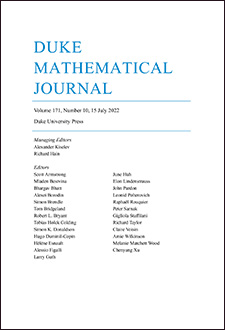Abstract
On any compact Riemannian manifold $(M, g)$ of dimension $n$, the $L\sp 2$-normalized eigenfunctions $\{\phi\sb \lambda\}$ satisfy $\lvert \rvert\phi\sb \lambda\lvert \rvert\sb\infty\leq C\lambda\sp {(n-1)/2}$, where $-\Delta\phi\sb \lambda=\lambda\sp 2\phi\sb \lambda$. The bound is sharp in the class of all $(M, g)$ since it is obtained by zonal spherical harmonics on the standard $n$-sphere $S\sp n$. But, of course, it is not sharp for many Riemannian manifolds, for example, for flat tori $\mathbb {R}\sp n/\Gamma$. We say that $S\sp n$, but not $\mathbb {R}\sp n/\Gamma$, is a Riemannian manifold with maximal eigenfunction growth. The problem that motivates this paper is to determine the $(M, g)$ with maximal eigenfunction growth. Our main result is that such an $(M, g)$ must have a point $x$ where the set $\mathscr {L}\sb x$ of geodesic loops at $x$ has positive measure in $S\sp \ast\sb xM$. We show that if $(M, g)$ is real analytic, this puts topological restrictions on $M$; for example, only $M=S\sp 2$ or $M=\mathbb {R}P\sp 2$ (topologically) in dimension $2$ can possess a real analytic metric of maximal eigenfunction growth. We further show that generic metrics on any $M$ fail to have maximal eigenfunction growth. In addition, we construct an example of $(M, g)$ for which $\mathscr {L}\sb x$ has positive measure for an open set of $x$ but which does not have maximal eigenfunction growth; thus, it disproves a naive converse to the main result.
Citation
Christopher D. Sogge. Steve Zelditch. "Riemannian manifolds with maximal eigenfunction growth." Duke Math. J. 114 (3) 387 - 437, 15 September 2002. https://doi.org/10.1215/S0012-7094-02-11431-8
Information





